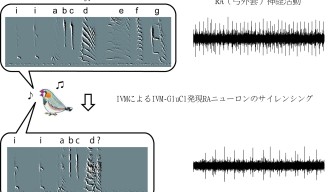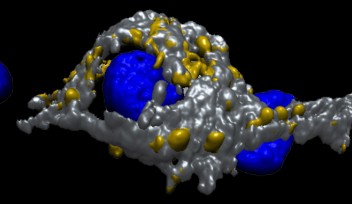Sounds of Silence

New research published by the Neuronal Mechanism for Critical Period Unit at the Okinawa Institute of Science and Technology Graduate University (OIST) has shown the effectiveness of chemogenetic inhibition used to suppress neuronal activity as well as interesting results on how vocalization is controlled through this technique's application in zebra finches. The research conducted by Professor Yoko Yazaki-Sugiyama and Dr. Shin Yanagihara of OIST was done in collaboration with scientists from the International Institute for Integrative Sleep Medicine at Tsukuba University and the Division of Sleep Medicine at Harvard University and shows that different areas of the brain govern unique aspects of vocalization.
The research showed that by silencing of neurons in the arcopallium, a region in the brain known to be responsible for song generation, zebra finch songs would become erratic and incomplete. Previous studies which used micro lesions on this area of the brain showed a diminished ability to sing almost all components of a song. The chemogenetic inhibition method revealed however that the song was only diminished at specific parts, with only some syllables being affected or absent. The syllables affected differed from bird to bird, however the order of syllables did not change. This suggests that the portion of the brain studied, the arcopallium, is in control of the composition of acoustic structure of songs and not their order or timing. It also demonstrated how precise this neuronal suppression method can be in determining the function of very small groups of neurons.
As it is with human speech, vocalization can be identified as a series of motor patterns, or a coordinated set of movements involving both reflex and voluntary actions. The creation of specific acoustic patterns requires well-coordinated neuronal circuitry. The identification of which group of neurons is responsible for a specific action or response is complex as brain scans such as functional magnetic resonance imaging, fMRI, can give only so much detail. Prof. Yazaki-Sugiyama explains, “Even though we know which general areas are functioning during certain tasks or behaviors, we have no idea how many of the neurons in that area are actually working. In some cases even a 5% change in neuron activity can have an effect.” New methods for examining the brains function in more detail, such as chemogenetic inhibition, have been refined and gaining popularity in the scientific community over the past ten years.
This technique had been previously applied to mice as a model animal and was demonstrated to be just as effective in zebra finches. The chemogenetic technique uses genetic manipulation to make neurons sensitive to selected chemicals or drugs. Once the neurons are modified, a predetermined drug can then be administered to temporarily deactivate these newly sensitive neurons. Previously one of the only other methods of blocking neuronal activity was by creating micro-lesions in parts of the brain where almost all of the neurons there are permanently damaged or killed. The technique implemented by Prof. Yazaki-Sugiyama is at the neuronal level and a temporary process, affecting only subsets of neurons. The finch’s ability to sing recovers within hours after the effect of the drug has worn off.
Zebra finches were used as a model because scientists understand their behavior, song patterns and brain anatomy well. Prof. Yazaki-Sugiyama wanted to determine what role a specific set of neurons plays in the brain area known to play a part in the finch’s song composition using chemogenetic methods. The finches were carefully observed and the patterns of their songs were recorded and analyzed with and without silencing neurons. With the effect of the drugs being only temporary as well as much more precise, the data Prof. Yazaki-Sugiyama was able to gather gives a much more detailed look at how unique neurons coordinate to produce vocalization.
The results themselves are not only interesting, but proof that the marriage between this highly refined technique and a well understood model animal in science has more to offer for future studies. Prof. Yazaki-Sugiyama adds “the technique itself is a causal one. So if you want to know the detail of how a general area in the brain functions, you could use this to silence the activity there and then see the behavioral change caused by the silencing. On top of that, one of the best merits of this is that its reversible as well, meaning we can be more thorough with follow ups in future research.”
by Sean To
Specialty
Research Unit
For press enquiries:
Press Inquiry Form

















